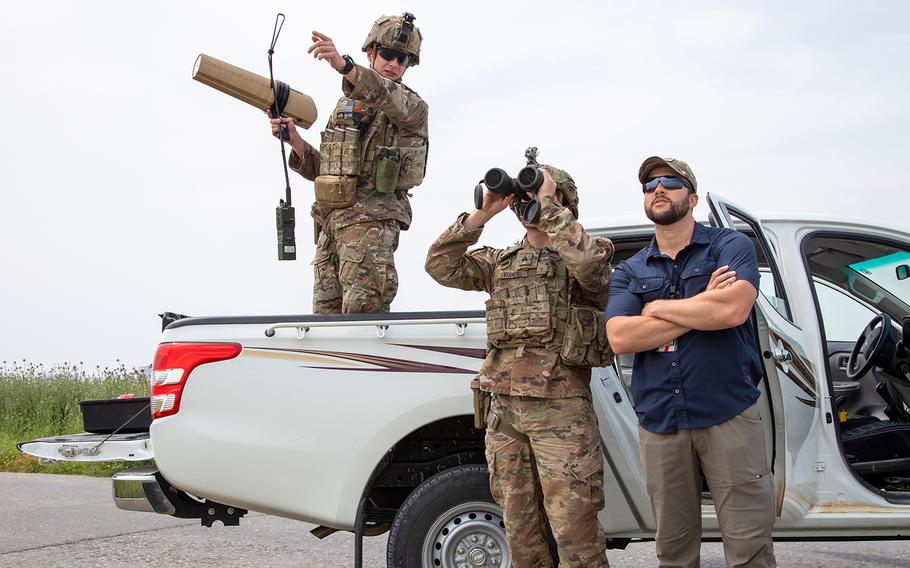
U.S. Army Sgt. Gage Stancell, right, looks through binoculars as Sgt. Gentry Squier describes where he saw a drone during an unmanned aerial system training exercise at Irbil Air Base in the Kurdistan Region of Iraq on April 24, 2020. (Angel Ruszkiewicz/U.S. Army)
WASHINGTON — The Pentagon wants to open a new school in the coming years specifically to teach troops to spot and kill small enemy drones, as the military seeks a uniform approach to defeating the small, unmanned aircraft, which officials have labeled a growing battlefield threat.
The Army-led Joint Counter-Small Unmanned Aircraft Systems Office hopes to open the new counter-small UAS academy in 2024 at Fort Sill, Okla., where it will become part of the Army’s Fires Center of Excellence, said Army Maj. Gen. Sean Gainey, the leader of that new office. Gainey’s new Arlington, Va.-based office was opened earlier this year as Pentagon officials placed an increased emphasis on the issue of small, often off-the-shelf drones that have been used against U.S. troops in the Middle East and Afghanistan in recent years.
“The [small drone] threat is evolving,” Gainey said recently. “Having a synergy at the [future] schoolhouse will help the force understand how to get after this problem.”
The issue has emerged in recent years as military officials have reported attacks on American troops in places such as Iraq and Syria by Islamic State militants who used devices such as commercial quadcopter drones to drop grenades or other explosives. Defense officials have said other groups, including the Taliban in Afghanistan, have used small drones in recent years to watch American troop movements.
In testimony before the House Armed Service Committee in March, Marine Gen. Kenneth McKenzie, leader of the U.S. Central Command, warned small drones were among the most worrying threats that he has seen in the region in recent history.
“The growing threat posed by UASs, coupled with our lack of dependable … capabilities to counter them, is the most concerning tactical development in the CENTCOM [region] since the rise of the improvised explosive device,” McKenzie said in his prepared remarks before the committee.
Among the issues that troops face in the fight against small drones is a scattershot, service-specific approach to defeating them, said Lt. Col. Dave Morgan, who works in the Joint Counter-Small Unmanned Aircraft Systems Office.
“There are currently no joint linkages or commonality to counter-UAS training across the [Defense] Department,” Morgan said Friday during a virtual briefing for the defense industry on his office. “Every service is executing service-specific training. The average soldier, airman or Marine lacks adequate counter-UAS training.”
The Pentagon has turned to the Army and Gainey’s new office to develop those tactics and strategies for the entire military to adopt to defeat intelligence-gathering and armed drones in categories ranging from the smallest, typically off-the-shelf drone models that weigh less than 20 pounds, to unmanned aircraft of up to about 1,300 pounds, such as Russia’s Forpost reconnaissance drones.
So far, Gainey said, the primary methods to defeat such aircraft is through electronic warfare measures, often via drone-killing weapons that use lasers or microwave signals to disrupt the communications link between the drone and its operators.
The Army hopes it can work with the defense industry quickly to develop new anti-drone weapons that can target enemy unmanned systems without interrupting friendly or noncombatant drones, Gainey said.
“We’re at the point now where we can talk to industry about our requirements and lay out to industry [that] these are the requirements that weren’t part of the original set of [counter-UAS] equipment that we want your help with, and that we want you to bring to our test ranges and show us what you’re doing to get after this capability-focus area,” he said.
dickstein.corey@stripes.com Twitter: @CDicksteinDC